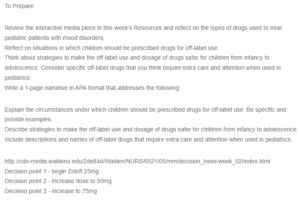Off-Label Drug Use in Pediatrics
Off-label drug use is very common in pediatric patients, with a reported prevalence estimated to be between 3.3% and 95% (Allen et al., 2018). This is attributed to the limited clinical trial data on safety and efficacy among children. While there are reported benefits supported by high-quality evidence, off-label drug use could be unsuitable and without any demonstrated therapeutic benefit (Egberts et al. 222). However, there are some circumstances under which children should be prescribed drugs for off-label use. These circumstances include an absence of standardized or licensed therapeutic options that are safe and effective for specific disease therapy. Other circumstances include an absence of alternative treatment options for these patient groups, failure of standard treatment choices, and supporting evidence showing benefit if used. Our assignment help will hone your writing prowess for papers that will awe your professors.
Selective serotonin reuptake inhibitors (SSRIs) such as Sertraline (Zoloft) are commonly used antidepressants in children and adults. Zoloft is FDA-approved for the management of obsessive-compulsive disorder with a dosing schedule beginning at 25 mg per day and reviewed to 50 mg per day as supported by clinical decision-making points (Dwyer & Bloch, 2019). However, data is scanty for pediatric Zoloft use in other conditions such as posttraumatic stress disorder. In clinical practice, there is a need to implement comprehensive strategies for off-label drug use among pediatric patients.
The Benefit and Risk Assessment for Off-label use (BRAvO) decision framework is an effective strategy to ensure safety in off-label drug use in children and adults (van der Zanden et al., 2022). Van der Zanden et al. (2022) explored the use of ondansetron in the management of nausea and vomiting in gastroenteritis. The alternative therapeutic approach in these patients is the use of oral rehydration to prevent dehydration. However, this fails to meet the pharmacological aspect of intervention and may result in dehydration and subsequent hospitalization. Risks for ondansetron use include QT interval prolongation and serotonin syndrome, alongside other adverse effects reported in adult patients. Administration of the appropriate dose of 0.1 mg/kg/dose to children between 1-6 months and 0.1 mg/kg to children between 3 and 12 years helps with risk mitigation. It ensures safety for off-label use of ondansetron in these patients (van der Zanden et al., 2022).
References
Allen, H. C., Garbe, M. C., Lees, J., Aziz, N., Chaaban, H., Miller, J. L., … & DeLeon, S. (2018). Off-label medication use in children, more common than we think: a systematic review of the literature. The Journal of the Oklahoma State Medical Association, 111(8), 776.
Dwyer, J. B., & Bloch, M. H. (2019). Antidepressants for pediatric patients. Current psychiatry, 18(9), 26.
Egberts, K. M., Gerlach, M., Correll, C. U., Plener, P. L., Malzahn, U., Heuschmann, P., … & Romanos, M. (2022). Serious adverse drug reactions in children and adolescents treated on-and off-label with antidepressants and antipsychotics in clinical practice. Pharmacopsychiatry, 55(05), 255-265.
van der Zanden, T. M., Mooij, M. G., Vet, N. J., Neubert, A., Rascher, W., Lagler, F. B., … & de Wildt, S. N. (2021). Benefit‐risk assessment of off‐label drug use in children: the bravo framework. Clinical Pharmacology & Therapeutics, 110(4), 952-965.
ORDER A PLAGIARISM-FREE PAPER HERE
We’ll write everything from scratch
Question

Off-Label Drug Use in Pediatrics
To Prepare:
Review the interactive media piece in this week’s Resources and reflect on the types of drugs used to treat pediatric patients with mood disorders.
Reflect on situations in which children should be prescribed drugs for off-label use.
Think about strategies to make the off-label use and dosage of drugs safer for children from infancy to adolescence. Consider specific off-label drugs that you think require extra care and attention when used in pediatrics.
Write a 1-page narrative in APA format that addresses the following:
Explain the circumstances under which children should be prescribed drugs for off-label use. Be specific and provide examples.
Describe strategies to make the off-label use and dosage of drugs safer for children from infancy to adolescence. Include descriptions and names of off-label drugs that require extra care and attention when used in pediatrics.
http://cdn-media.waldenu.edu/2dett4d/Walden/NURS/6521/05/mm/decision_trees/week_02/index.html
Decision point 1 – begin Zoloft 25mg
Decision point 2 – Increase dose to 50mg
Decision point 3 – increase to 75mg

